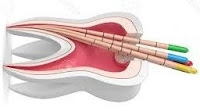Tug back refers to:
1- Retention of GP inside the canal. ***
2- Fluibilty of GP.
--------------------------
Conventionally, a gutta-percha (GP) cone with sealant is used to seal the canal. GP cones are available in standard and non-standard sizes. Currently, manufacturers offer GP cones corresponding to the cone and the diameter of the instruments. Previous studies have shown that such tapered general contact points effectively seal the canal when a single cone technique is used.
Three-dimensional filling of the root space is essential for long-term success. Whatever the obturation technique used, it is important to choose a main cone well suited to the canal to obtain a tight apical seal. Previous studies have shown that plugging the root canal with a single cone with paired taper provides better apical sealing compared to other master cones.
The adaptation of the master cones is assessed by visual, tactile and radiographic methods. When mounting a cone, a clinician confirms that the GP cone is inserted at the established working length (WL) with a pull back. X-rays could also be used to confirm the fit of the main cone.
According to the American Association of Endodontists, Tug-Back is defined as a slight resistance of friction of a master point to withdrawal, which indicates a relative degree of adaptation at least in 2 dimensions. Backtracking has also been described as slight tensile strength, a tactile sensation of apical sharpness, and slight backward pulling or resistance to dislodging the GP main cone, felt when removed from the canal.
The influence of the adaptation of the main cone on the apical sealing has been studied by several studies. However, no attempt has been made to quantitatively compare the subjective feeling of tightness with the suitability of the master cone. The objective of this study was to examine the correlation between the degree of tightness and the adaptation of the apical cone. We have developed a protocol to quantify the subjective backtrack by measuring the pulling force with a spring balance. We compared the tactile tightness scores, the tensile force and the percentage of the surface occupied by the gutta-percha (pGPOA) by micro-computed tomography (µCT) in conjunction with a generalist mp cone of different conicities.
MATERIALS AND METHODS:
Human teeth extracted from a single root were removed after informed consent from the Institutional Study Council of Daejeon Hospital at Wonkwang University (W1601 / 0011). Twenty-eight human teeth with a single root with a single straight channel (curvature).
--------------------------
Conventionally, a gutta-percha (GP) cone with sealant is used to seal the canal. GP cones are available in standard and non-standard sizes. Currently, manufacturers offer GP cones corresponding to the cone and the diameter of the instruments. Previous studies have shown that such tapered general contact points effectively seal the canal when a single cone technique is used.
Three-dimensional filling of the root space is essential for long-term success. Whatever the obturation technique used, it is important to choose a main cone well suited to the canal to obtain a tight apical seal. Previous studies have shown that plugging the root canal with a single cone with paired taper provides better apical sealing compared to other master cones.
The adaptation of the master cones is assessed by visual, tactile and radiographic methods. When mounting a cone, a clinician confirms that the GP cone is inserted at the established working length (WL) with a pull back. X-rays could also be used to confirm the fit of the main cone.
According to the American Association of Endodontists, Tug-Back is defined as a slight resistance of friction of a master point to withdrawal, which indicates a relative degree of adaptation at least in 2 dimensions. Backtracking has also been described as slight tensile strength, a tactile sensation of apical sharpness, and slight backward pulling or resistance to dislodging the GP main cone, felt when removed from the canal.
The influence of the adaptation of the main cone on the apical sealing has been studied by several studies. However, no attempt has been made to quantitatively compare the subjective feeling of tightness with the suitability of the master cone. The objective of this study was to examine the correlation between the degree of tightness and the adaptation of the apical cone. We have developed a protocol to quantify the subjective backtrack by measuring the pulling force with a spring balance. We compared the tactile tightness scores, the tensile force and the percentage of the surface occupied by the gutta-percha (pGPOA) by micro-computed tomography (µCT) in conjunction with a generalist mp cone of different conicities.
MATERIALS AND METHODS:
Human teeth extracted from a single root were removed after informed consent from the Institutional Study Council of Daejeon Hospital at Wonkwang University (W1601 / 0011). Twenty-eight human teeth with a single root with a single straight channel (curvature).
